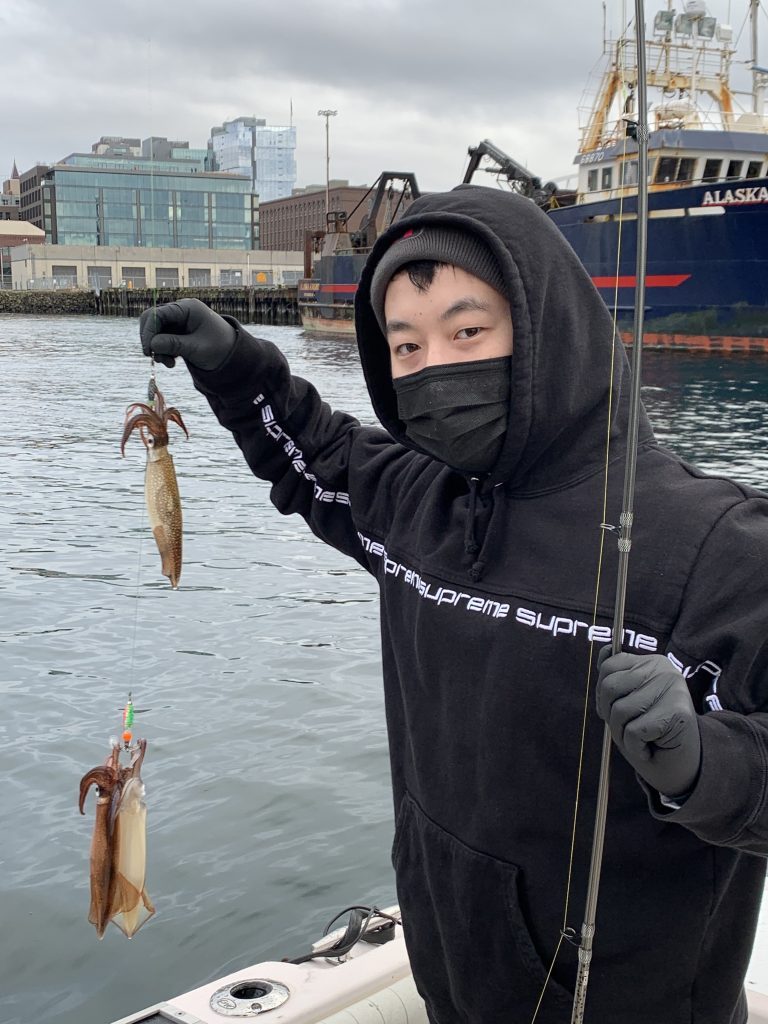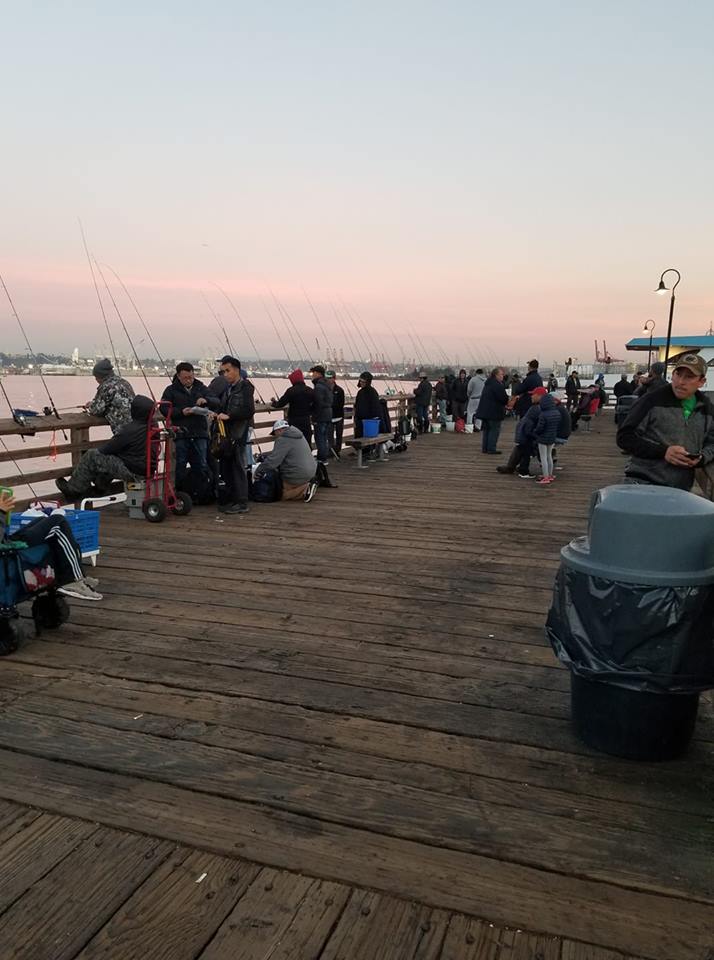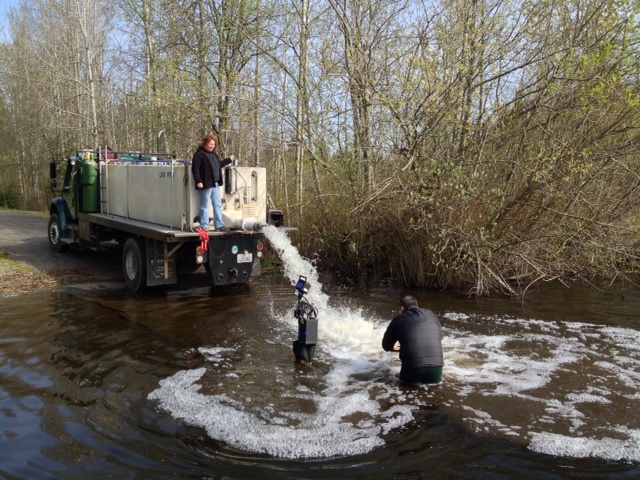Squid jigging around Puget Sound finally picks up for pier and boat anglers plus several other worthwhile fishing adventures Leave a reply

Contributed by Mark Yuasa
Squid jigging is mainly a night-time affair around Puget Sound and much of this season has been a head scratcher for pier anglers although action ramped up this week and those in boats continue to find better catches mainly in Elliott Bay and a few surrounding areas.
“Squid fishing has picked up for the pier folks in Edmonds and some evenings in downtown Seattle piers,” said Paul Kim, owner of Seattle Squid charter service in Seattle (https://www.facebook.com/SeattleSquid/). “We did very well last Sunday with limits for five boat anglers.”
Squid jiggers in boats have found an abundance of squid in Elliott Bay, off the Edmonds Marina and in the Des Moines and Redondo areas.
It appears the mass of migrating squid are finally moving from deeper water into shallower location to spawn and lay their eggs along the gentle sloping rocky bottoms around local piers.
Many have questioned why anyone would want to eat something from the polluted waters of our local bays, but keep in mind squid are migratory so they don’t ingest pollutants like a bottomfish.
Migrating squid usually make an early appearance from September to October. The best jigging occurs from late November through January with numbers peaking in December.
Squid jigging was also on the slow side in the fall and winter of 2021-2022, but prior to that hordes of squid arrived as early as September and has always been a blessing for anglers across Puget Sound especially when other marine fishing options are few and far in between.

Squid jigging is a relatively easy and great introductory fishery and has seen a substantial increase in participation over the past several years especially since accessibility is simple and success rates can be good when returns are strong.
Night-time on a flood tide is usually best period as squid are attracted to light, which is why public piers are great spots to catch them. Many will bring their own powerful lanterns to dangle just off the surface of the water.
Squid tend to hide in the dark, shadowy edges of lighted water and then dart out into the light on their unsuspecting prey.
The most popular land-based places to catch squid are along the entire Seattle waterfront from Pier 70 to the Big Wheel; the Seattle Aquarium Pier; the Seacrest (Marination) Boathouse Pier in West Seattle; Edmonds Pier; Des Moines Pier; A-Dock and Shilshole Pier; Point Defiance Park Boathouse Pier; Les Davis Pier in Tacoma; Fauntleroy Ferry Dock; Illahee State Park Pier; and the Waterman and Indianola piers in Kitsap County.
You don’t need a bunch of expensive fishing gear when it comes to squid jigging and a simple trout rod and spinning reel will get the job done. Be sure to use a lightweight fishing line of 5- to 6-pound test, which will allow you to feel the subtle tap or vibration of a squid hitting the jig.
The weighted jigs are luminous or light-up plastic versions that come in a wide-range of colors such as pink, chartreuse, blue, red, green, orange or no-color at all. Jigs don’t have “hooks” and instead have upward slanting sharp prongs. This means when you get a squid(s) on your line be sure to keep a steady pressure when reeling up and don’t jerk or reel too fast. Unweighted lures are also used by squid jiggers that attach to a one-ounce lead weight.
Regulations say no more than four lures may be used at one time so often anglers will “gang-tie” multiple jigs to their main-line. The WDFW website has information on catching squid by going to https://wdfw.wa.gov/fishing/basics/squid.
Nibbles and bites

- If you’re planning on setting pots for winter Dungeness crab you can now add central Puget Sound (Marine Area 10) and south-central Puget Sound (Marine Area 11) to list of places to go, which are open daily through Dec. 31. Both areas have seen some pretty good fishing for large size Dungeness crabs. Others also open during the same timeframe include east of the Bonilla-Tatoosh line (4), Sekiu-Pillar Point (5), eastern Strait of Juan de Fuca (6), San Juan Islands (7), eastern side of Whidbey Island (8-1 and 8-2), northern Puget Sound/Admiralty Inlet (9), and Hood Canal north of a line projected true east from Ayock Point (12). Coastal areas are also open year-round for crab fishing. For more information including regulations, go to https://wdfw.wa.gov/fishing/shellfishing-regulations/crab.
- We know the holiday celebrations might’ve gotten in the way of getting out to the Black Friday statewide trout fishing event, but keep in mind that not all the thousands of planted jumbo-sized fish averaging one to two pounds apiece were caught and are still swimming around in lakes around Clark, Cowlitz, Island, Jefferson, King, Klickitat, Lewis, Mason, Pierce, Snohomish, Thurston, and Yakima counties. To add to the fishing fun, roughly 75 other year-round lakes around Washington were also planted with trout in October and some will continue to receive additional plants. Click on this link at https://wdfw.wa.gov/fishing/reports/stocking/trout-plants for the WDFW weekly trout plants. You can also go to this WDFW blog for additional information on the Black Friday event at https://wdfw.wa.gov/newsroom/news-release/black-friday-skip-shopping-and-hit-water-big-rainbow-trout.
- Even though the south-central Puget Sound (Marine Area 11) salmon fishery has closed, you can still find a few hatchery winter Chinook salmon lurking in southern Puget Sound (Marine Area 13) which remains open year-round for salmon fishing. Improved success for Chinook salmon during the winter usually coincides with locating schools of baitfish. Target fish off Gibson Point and Point Fosdick, Fox Point in Hale Passage, northwest corner at the Sand Spit, Toy Point, the Concrete Dock Fox Island Fishing Pier, Itsami Ledge, and Johnson Point. Many piers around Puget Sound are also open year-round for salmon fishing.
- The recreational coastal razor clam season remains postponed on all beaches until further notice, as test results on razor clams indicate a marine toxin, known as domoic acid, have exceeded the health guidelines for safe consumption set by the Washington Department of Health. WDFW shellfish staff will continue to regularly dig test samples of razor clams to monitor the situation. Two test samples taken 10 days apart, must fall under the health guideline level before a beach can reopen for digging. WDFW will announce future opportunities when marine toxin tests show it is safe to do so.
- Large kokanee can be found in the winter at Lake Roosevelt, a huge 77,684-acre impoundment of the Columbia River. Most of the kokanee average 13 to 17 inches but there are some weighing up to 5 pounds. Look for kokanee in the lower third of the impoundment from the Grand Coulee Dam to above the Sanpoil River at Clark. These wild kokanee grow fast due to an abundant biomass of daphnia and other zooplankton. The nearest boat launch is located at Keller in Clark. Seek out kokanee at Hanson Harbor; near the Spring Canyon boat ramp; Swawilla Basin; Camel Bluff; off the Sanpoil River mouth to China Bluff and Moonbeam Bay; and the Sanpoil Arm.
- North central Washington’s Rufus Woods Reservoir, located on the Columbia River between Chief Joseph and Grand Coulee dams, is a hot spot during the cold winter months for rainbow trout averaging 2 to 6 pounds with some in the high teens. The Colville Confederated Tribes in cooperation with the Washington Department of Fish and Wildlife produce about 14 million pounds annually of trout known as “triploids.” The best shoreline area on the westside is located on reservation land near the net pens requires a tribal permit to fish. The nearest boat launches to the net pens are located at Tim’s Ranch and Coyote Creek. An annual permit to fish or use facilities on the reservation is $80. To buy a permit visit https://colville.nagfa.net/online/ or https://www.colvilletribes.com. A map of Rufus Woods can be found at https://www.cct-fnw.com/program-1. There are numerous other boat ramps nearby at Seaton’s Grove located near Elmer City below Grand Coulee Dam and is about an eight-mile boat to the upper net pen. The lower net pen is about 33 miles above Chief Joseph Dam, and the middle net pen is closest to the mouth of Nespelem Creek where a flat is located.
(Mark Yuasa is a Washington Department of Fish and Wildlife Communications Manager and longtime contributor to ESPN 710 KIRO The Outdoor Line. He also was the fishing and hunting reporter at The Seattle Times for 28 years.)

